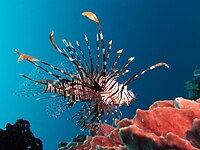
Photo from wikipedia
Modified fish behaviors in response to anthropogenic stressors, such as chemicals, microplastics, acoustic emissions and fisheries, are a debated driver of change in freshwater ecosystems and oceans. Our ability to… Click to show full abstract
Modified fish behaviors in response to anthropogenic stressors, such as chemicals, microplastics, acoustic emissions and fisheries, are a debated driver of change in freshwater ecosystems and oceans. Our ability to judge the severity of observed behavioral responses is hampered by limited knowledge regarding how subtle behavior modifications in prey fish affect ecosystems. Here we show that anthropogenic stressors affecting fish boldness are not expected to cause population collapse, but rather elusive effects on fish length, population biomass, reproduction and ecosystem state shifts. We use a physiologically structured population model (three trophic levels), well fed with empirical data, to simulate how previously suggested alterations of fish boldness traits due to anthropogenic stressors affect ecosystem structure. Our results suggest that these stressors may cause ecosystem structure effects, such as skewed size distributions, reduced fish biomass and reduced reproduction success, by altering the foraging behavior of fish. However, the specific structure effects depend on where the boldness–shyness continuum change occurs and on the species‐specific life stages. The model also highlights somewhat counterintuitive effects leading to possible extinction of predators when the foraging behavior of the prey is hampered. We conclude that anthropogenic forcing of fish behavior may be a hidden mechanism behind ecosystem structure changes in both freshwater and marine ecosystems.
Journal Title: Global Change Biology
Year Published: 2020
Link to full text (if available)
Share on Social Media: Sign Up to like & get
recommendations!